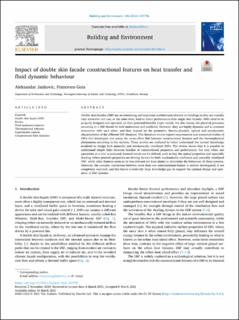| dc.contributor.author | Jankovic, Aleksandar | |
| dc.contributor.author | Goia, Francesco | |
| dc.date.accessioned | 2021-04-06T09:53:21Z | |
| dc.date.available | 2021-04-06T09:53:21Z | |
| dc.date.created | 2021-04-01T08:39:02Z | |
| dc.date.issued | 2021 | |
| dc.identifier.citation | Building and Environment. 2021, 196, . | en_US |
| dc.identifier.issn | 0360-1323 | |
| dc.identifier.uri | https://hdl.handle.net/11250/2736337 | |
| dc.description.abstract | Double skin facades (DSF) are an interesting and important architectural element in buildings as they are visually very attractive and can, at the same time, lead to better performance than single skin facades. DSFs need to be properly designed and operated, or their potential benefits might vanish. For this reason, the physical processes occurring in a DSF should be well understood and predicted. However, they are highly dynamic and in constant interaction with each other, and they depend on the geometric, thermo-physical, optical and aerodynamic characteristics of the different DSF elements. This literature review reports experimental and numerical studies of DSFs that investigate and assess the cause-effect link between constructional features and the thermophysical phenomena occurring in the systems. These studies are analyzed to better understand the current knowledge available to design both naturally and mechanically ventilated DSFs. The review shows that it is possible to understand simple links between families of constructional properties and performance, but only when one parameter at a time is analyzed. General trends can be defined, such as that the optical properties and especially shading (when present) properties are driving factors for both mechanically ventilated and naturally ventilated DSF, while other features seem to be less relevant (at least alone) to determine the behaviour of these systems. However, the complex interaction between more than one constructional feature is seldom investigated, if not completely explored, and this leaves a relatively large knowledge gap to support the optimal design and operation of DSF systems. | en_US |
| dc.language.iso | eng | en_US |
| dc.publisher | Elsevier | en_US |
| dc.rights | Navngivelse 4.0 Internasjonal | * |
| dc.rights.uri | http://creativecommons.org/licenses/by/4.0/deed.no | * |
| dc.title | Impact of double skin facade constructional features on heat transfer and fluid dynamic behaviour | en_US |
| dc.type | Peer reviewed | en_US |
| dc.type | Journal article | en_US |
| dc.description.version | publishedVersion | en_US |
| dc.source.pagenumber | 32 | en_US |
| dc.source.volume | 196 | en_US |
| dc.source.journal | Building and Environment | en_US |
| dc.identifier.doi | 10.1016/j.buildenv.2021.107796 | |
| dc.identifier.cristin | 1901895 | |
| dc.relation.project | Norges forskningsråd: 262198 | en_US |
| dc.description.localcode | This is an open access article distributed under the terms of the Creative Commons CC-BY license, which permits unrestricted use, distribution, and reproduction in any medium, provided the original work is properly cited. | en_US |
| dc.source.articlenumber | 107796 | en_US |
| cristin.ispublished | true | |
| cristin.fulltext | original | |
| cristin.qualitycode | 2 | |

